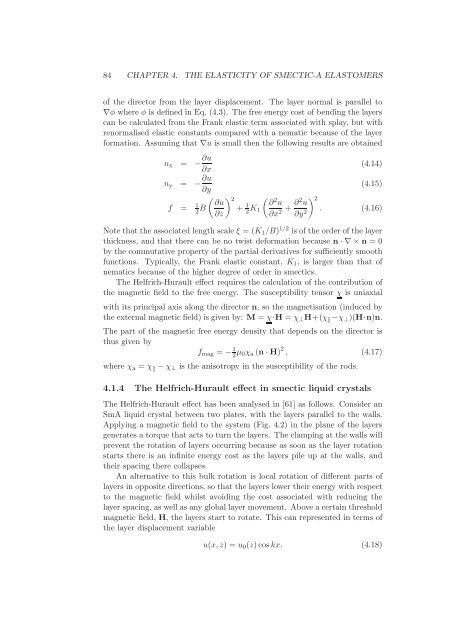Statistical models of elasticity in main chain and smectic liquid ...
Statistical models of elasticity in main chain and smectic liquid ...
Statistical models of elasticity in main chain and smectic liquid ...
You also want an ePaper? Increase the reach of your titles
YUMPU automatically turns print PDFs into web optimized ePapers that Google loves.
84 CHAPTER 4. THE ELASTICITY OF SMECTIC-A ELASTOMERS<strong>of</strong> the director from the layer displacement. The layer normal is parallel to∇φ where φ is def<strong>in</strong>ed <strong>in</strong> Eq. (4.3). The free energy cost <strong>of</strong> bend<strong>in</strong>g the layerscan be calculated from the Frank elastic term associated with splay, but withrenormalised elastic constants compared with a nematic because <strong>of</strong> the layerformation. Assum<strong>in</strong>g that ∇u is small then the follow<strong>in</strong>g results are obta<strong>in</strong>edn x = − ∂u∂xn y = − ∂u∂yf = 1 2 B ( ∂u∂z) 2+ 1 2 K 1(4.14)(4.15)( ∂ 2 u∂x 2 + ∂2 u∂y 2 ) 2. (4.16)Note that the associated length scale ξ = (K 1 /B) 1/2 is <strong>of</strong> the order <strong>of</strong> the layerthickness, <strong>and</strong> that there can be no twist deformation because n·∇×n = 0by the commutative property <strong>of</strong> the partial derivatives for sufficiently smoothfunctions. Typically, the Frank elastic constant, K 1 , is larger than that <strong>of</strong>nematics because <strong>of</strong> the higher degree <strong>of</strong> order <strong>in</strong> <strong>smectic</strong>s.The Helfrich-Hurault effect requires the calculation <strong>of</strong> the contribution <strong>of</strong>the magnetic field to the free energy. The susceptibility tensor χ is uniaxialwith its pr<strong>in</strong>cipal axis along the director n, so the magnetisation (<strong>in</strong>duced bythe external magnetic field) is given by: M = χ·H = χ ⊥ H+(χ ‖ −χ ⊥ )(H·n)n.The part <strong>of</strong> the magnetic free energy density that depends on the director isthus given byf mag = − 1 2 µ 0χ a (n·H) 2 , (4.17)where χ a = χ ‖ −χ ⊥ is the anisotropy <strong>in</strong> the susceptibility <strong>of</strong> the rods.4.1.4 The Helfrich-Hurault effect <strong>in</strong> <strong>smectic</strong> <strong>liquid</strong> crystalsThe Helfrich-Hurault effect has been analysed <strong>in</strong> [61] as follows. Consider anSmA <strong>liquid</strong> crystal between two plates, with the layers parallel to the walls.Apply<strong>in</strong>g a magnetic field to the system (Fig. 4.2) <strong>in</strong> the plane <strong>of</strong> the layersgenerates a torque that acts to turn the layers. The clamp<strong>in</strong>g at the walls willprevent the rotation <strong>of</strong> layers occurr<strong>in</strong>g because as soon as the layer rotationstarts there is an <strong>in</strong>f<strong>in</strong>ite energy cost as the layers pile up at the walls, <strong>and</strong>their spac<strong>in</strong>g there collapses.An alternative to this bulk rotation is local rotation <strong>of</strong> different parts <strong>of</strong>layers <strong>in</strong> opposite directions, so that the layers lower their energy with respectto the magnetic field whilst avoid<strong>in</strong>g the cost associated with reduc<strong>in</strong>g thelayer spac<strong>in</strong>g, as well as any global layer movement. Above a certa<strong>in</strong> thresholdmagnetic field, H, the layers start to rotate. This can represented <strong>in</strong> terms <strong>of</strong>the layer displacement variableu(x,z) = u 0 (z)coskx. (4.18)
















